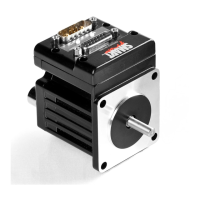Moog Animatics SmartMotor™ Developer's Guide,Rev. L
Page 658 of 909
PT=formula
Position, (Absolute) Target
APPLICATION: Motion control
DESCRIPTION: Get/set absolute target position
EXECUTION: Buffered until a G command is issued
CONDITIONAL TO:
MP (position mode)
LIMITATIONS: N/A
READ/REPORT: RPT
WRITE: Read/write
LANGUAGE ACCESS: Assignment, formulas and conditional testing
UNITS: Encoder counts
RANGE OF VALUES: -2147483648 to 2147483647 (see NOTEin Detailed Description)
TYPICAL VALUES: -1000000000 to 1000000000
DEFAULT VALUE: 0
FIRMWARE VERSION: 5.x and later
COMBITRONIC: PT:3=1234
where ":3" is the motor address — use the actual address or a
variable
DETAILED DESCRIPTION:
The PTcommand is used to get (read) or set absolute target position.
To specify an absolute target position to the SmartMotor’s™ position origin, set PT=target
position (either positive or negative) and then follow with a G command.
PT=formula sets the target position in Position mode.
NOTE: While PT= allows a range of -2,147,483,648 to +2,147,483,647, at these
extremes, the relative distance from one end to the other is greater than 32-bits.
Therefore, the calculated move within the motor will overflow and may move
opposite of the expected direction. To avoid this problem, a best practice is to keep
the motor target position within the "typical values" range: -1000000000 to
+1000000000.
If the appropriate trajectory parameters ADT and VT are specified, then the motor will move,
when the G command is issued, to the position specified by the last PT value requested.
Status word 3, bit 8 reports 0 when acting on a PT target (absolute position).
RPT will report the actual position. However, if you set a variable equal to PT, such as a=PT,
that variable will be loaded with the last-entered target position rather than the actual
position. If you want to use the actual position in your program, then use a PA variable such
as a=PA.
Part 2: Commands: PT=formula

